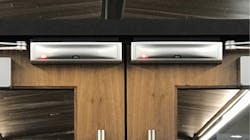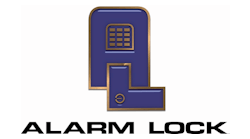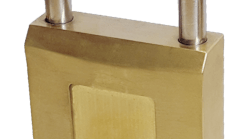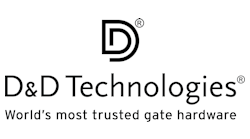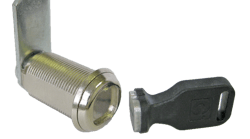Electromagnetic locks, or maglocks, possess unique characteristics that make them work where ostensibly nothing else will. I have used maglocks for decades, and I like them, but I also respect and recognize the pros and cons.
The pros:
- They can be used on loosely fitted doors and gates where conventional latching hardware can’t.
- They’re relatively simple to mount.
- They provide a powerful locking bond.
The cons:
- They require power to lock. (Maglocks unlock when power is absent.)
- Unlike mechanical locks and locksets, they don’t have an integral means to unlock them.
There are two workarounds for the latter problem: You can use a battery-backup power supply or a latching mechanical lock in conjunction with the maglock.
Maglock History
Some of the first projects I worked on that involved maglocks were on commercial buildings in an industrial park where the main exterior doors were locked in the evening and unlocked in the morning. The maglocks were discreet, and management could be reasonably certain that the doors would be secure after hours.
Management loved my suggestion to place narrow-stile illuminated red and green lights on the exterior mullions, so roving security patrol could identify that the maglocks were powered and the doors secure without having to walk up to the door and physically test that it was locked. The maglocks also were tied into the fire-alarm system so they would unlock when a fire alarm was triggered.
However, maglocks were in use for years before building codes were written to encourage their safe deployment or confirm that they performed to their published levels of performance. Because a maglock is relatively easy to install, without life-safety guidelines or enforcement, occupants sometimes were trapped inside buildings by maglocks that failed to unlock during an emergency. As a result, maglocks were outlawed in many jurisdictions and forbidden for many applications.
In 1991, ANSI released the first standard for maglocks. Installers, fire marshals and building inspectors were brought up to speed, and the situation improved over time, although maglocks still might not be allowed in some areas.
Today, maglock standards are governed by ANSI/BHMA A156.23-2017, as well as multiple standards by UL, including the following:
- UL Listed - GWXT Auxiliary Lock indicates the maglock has been tested for electrical safety and the purpose for which it was intended.
- UL10C indicates the maglock complies with the Uniform Building Code standard 7-2 “Fire Test for Door Assemblies.”
A “C” preceding the listing symbol indicates that the product is also UL Listed for use in Canada. It’s advised that you use only UL Listed maglocks.
Allegion Interview
For more on maglocks and the role they play in providing safe security, we spoke with Mason Stacy, DHT, DHC, CDI, who is a specification consultant with Allegion.
Locksmith Ledger: What do you do at Allegion?
Mason Stacy: The biggest part of my job is assisting architects with their 087100 specifications and helping to coordinate with other divisions to ensure everything door- or hardware-related goes smoothly. A coworker of mine sometimes says, “Hardware may be 2% of your project, but it can be 98% of your headache if not done properly.”
LL: Where do you see maglocks most often used?
Stacy: Mostly on storefront entry doors. Other common applications are for delayed or controlled egress in a hospital setting or used in an interlock system. Sometimes [I see them] on retrofits, such as a stairwell where access control is requested after the fact and it’s cost-prohibitive to change to an electrified fail-safe lockset.
LL: How often do you specify maglocks?
Stacy: I typically don’t unless it’s what the end user wants or the best application. I prefer to use electrified locks or [exit devices] and electric strikes, because in their nonpowered state, they can be ordered fail-secure. This way, I don’t have to worry as much about unauthorized ingress, and the extra code requirements don’t come into play.
LL: What role do maglocks play in life safety?
Stacy: A big role. Sometimes, there’s a little confusion about them, because the code requirements are different compared with using a normal locking arrangement. For example, in a typical installation where free egress is allowed, an electrified lock, electrified exit device or electric strike won’t inhibit egress, because these devices, unless you have a delayed-egress exit device, allow free egress independent of the access control system.
Electromagnetic locks are considered a special locking arrangement, because a door that has an electromagnetic lock won’t allow free egress unless the magnet is released by a sensor or a switch in the door-mounted hardware. On top of the sensor release, you have to have an auxiliary push-button and release upon power failure and the activation of the fire alarm. You aren’t required to have an auxiliary push-button or fire-alarm release if the electromagnetic lock is released via a switch in the door-mounted hardware. Check with your authority having jurisdiction (AHJ) though, because they still might want to see these redundant release methods.
LL: How do the codes vary between states with regard to maglocks?
Stacy: In most cases, states adopt the IBC and or NFPA 101. It’s always good to go off your state’s building code though and verify what’s applicable with the local AHJ. I have personally experienced that in certain counties, the inspectors won’t allow electromagnetic locks, even though the state code allows their use.
LL: What should locksmiths know in particular about codes that affect maglocks?
Stacy: There are two options when using electromagnetic locks. Option 1 is sensor release. The current IBC Section is called “Sensor Release of Electromagnetically Locked Egress Doors”. Prior to IBC 2015, it was called “Access-Controlled Egress Doors.” For NFPA 101, the section is “Sensor-Release of Electrical Locking Systems.” Prior to the 2018 edition, it was called “Access-Controlled Egress Door Assemblies.”
Option 2 is Door Hardware Release, such as a request-to-exit switch in an exit device. The current IBC section is “Door Hardware Release of Electrically Locked Egress Doors.” Prior to the 2018 edition, it was “Electromagnetically Locked Egress Doors.” For NFPA, the section is “Door Hardware Release of Electrically Locked Egress Door Assemblies.” Prior to the 2018 edition, it was called “Electrically Controlled Egress Door Assemblies.” (It’s worth noting the differences in nomenclature, because not all jurisdictions use the latest version of either code.)
From the prior code additions, only the names were changed, because a handful of AHJs were trying to apply “Access Controlled Egress Doors” to any door that had an access control reader. The codes addressed this in their commentary, but now the sections have been changed for clarity.
One change that affects electromagnetic locks in the coming 2024 IBC is that the sensor-release option no longer will be allowed on applications that have exit devices. So, in a handful of years from now, and if your jurisdiction adopts 2024 IBC, you would have to use option 2 if you use electromagnetic locks and exit devices.
Following are some maglock options for your code-compliant application.
Securitron EcoMag series
The Securitron M680E and M380E Series combine security and convenience, along with an up to 80% reduction in energy consumed. The M680E has 1,200 pounds of holding force; the M380E has 600 pounds.
Both models have optional door prop sensing that allows the magnet to de-energize the coil when the door is held open for extended periods, as well as optional integrated REX. The EcoMag’s updated strike-plate mounting template makes for faster, easier installation, and their size makes them optimal for use with door closers.
More info: www.securitron.com
Dortronics ML-1100
Dortronics ML-1100 Mortise Lock and Door Pull Series is designed for high-security applications that also require high aesthetics. The maglocks feature a holding force of 1,000 pounds and a pull handle that allows for concealment of the locking hardware, which makes it suited for use in building lobbies and vestibule entrances. The door pull even can be custom engraved.
Although the ML-1100 locking device ensures instant release upon command or loss of power, the “direct pull” design insures maximum holding force for enhanced security.
The ML-1100 can be controlled individually or simultaneously from one or many locations. The status of the lock can be monitored by any card-access system via an optional Magnetic Bond Sensor (MBS), which signals that the lock is energized and holding.
More info: dortronics.com
SDC EMLocks
SDC’s patented EMLocks are a “U” channel, epoxy-less maglock, which makes them immune to core distortion and reduction of their electromagnetic holding force.
- 1510 Series – 1,650 pounds of holding force
- 1570 Series – 1,200 pounds of holding force
- 1580 Series – 650 pounds of holding force
More info: sdcsecurity.com
Hager 2941, 2942
The Grade 1 2941 and 2942 maglocks by Hager feature field-selectable 12 or 24VDC input, a door-position sensor, a lock-status sensor and a PC board that has voltage and current spike protection. The 2941 (1,200 pounds of holding force) and 2942 (600 pounds of holding force) meet fire-safety requirements for fail-safe applications.
More info: https://www.hagerco.com/
RCI 8310/8320-IQ IntelliMag
dormakaba brand RCI has a wide range of maglocks for different applications. The IntelliMag series, which has 1,200 pounds of holding force, is designed for high-security applications. It has an intelligent magnet that recognizes only its own armature plate, which prevents anyone from “tricking” the magnet by using a separate plate. Each encoded armature plate is registered individually to match its own electromagnetic lock.
Other features include two independent relay outputs to allow for lock status and alarm status for local or remote indication, alarm time setting, surge protection and built-in time delay, programmable from zero to 90 seconds.
This series has keyhole mounting for ease of installation, an easy-access wiring cavity and stabilizing four-bolt “drop stop” mounting. The 8310 is for a single door; the 8320 is for double doors.
More info: www.dormakaba.com
SECO-LARM E-941-SA DSPQ series
The DSPQ series is part of SECO-LARM’s wide E-941-SA line of maglocks for single doors. The series comes in 1,200-pound and 600-pound models and includes, built-in:
- A bond sensor that has a 3-amp dry relay output for monitoring the lock status of the door
- An LED that changes color to show lock status
- A door-position sensor that shows open or closed status (a one-half-inch gap)
In addition, the maglocks have selectable dual voltage. SECO-LARM also has a wide assortment of mounting brackets for indoor, outdoor or inswing installations.
More info: www.seco-larm.com
Door King DKGL Series
The Door King DKGL Series of maglocks are designed for outdoor gate applications.
The DKGL-S12-1 or 1L has 1,200 pounds of locking force and is aimed at vehicle gates, with the DKGL-S6-1 has 600 pounds of locking force is aimed at use on pedestrian gates.
The S12 also provides an electrical enclosure with predrilled and tapped conduit holes on the top, bottom, side and back for easy wiring and installation. (The 1L version includes a built-in lock-status relay.) The S6 includes a built-in cable assembly for all wiring connections.
In addition, Door King sells gate lock kits that include a maglock and lock and armature mounting brackets.
More info: www.doorking.com
Tim O’Leary is an experienced security consultant and a regular contributor to Locksmith Ledger.
